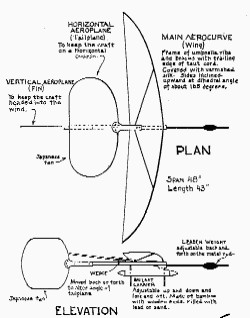|

Click
on the image to download a 1000
pixel wide plan.
The following extract
is from the book "James Means and the Problem of Manflight" by
his son James Howard Means. The book was published by the Smithsonian
Institution in 1964.
...having liberated himself from what he regarded as the shackles of
business, he established the family for the summer in a cottage in York
Harbor, Maine, and set to work in earnest. "I spent," said he,
"the greater part of my time in working at the bench and in the
field." I well remember the attic workshop he fixed up, in which he
built his models and from the window of which he sometimes launched them.
The neighbors, I am sure, considered him eccentric, if not a little balmy,
but this did not disturb him in the least.
His better
builidng materials show his practical ingenuity. The
"backbone" of his structure was of light wood (pine, I think),
and its wings of about three feet span were fashioned from a pair of
umbrella ribs, bent to whatever degree he wished and covered with tightly
stretched and varnished silk. For his tail assemblies he found Japanese
fans made of bamboo and paper to be very satisfactory.
He soon
abandoned his attempts at automatic stabilization by means of pendulums
and narrowed his study to that of shape and size of airfoils and center of
gravity. After noting the glide of a model, he would alter some one factor
slightly and try again. In this way of trial and error he improved the
performance of his gliding model considerably. Indeed of his final model
of the summer of 1894 he had this to say:
"Having altered my design after every trial, I can now
offer to experimenters the drawing of an instrument which will, I think,
be useful to them in begtinning a series of investigations. It involves
no new principle, but as the result of experiment it is proportioned in
such a way that it will soar instructively. Whatever the merits or the
faults of the design may be, its dimensions are given, and anyone may
test it."
This is indeed a modest
statement. In restrospect, I have little doubt that if his model were
blown up to mansized, and equipped with proper controls, a modern gilder
pilot would be able to fly it. Possibly it was of better design than that
of the comtemporary apparatus in which Otto Lilienthal lost his life.
|
